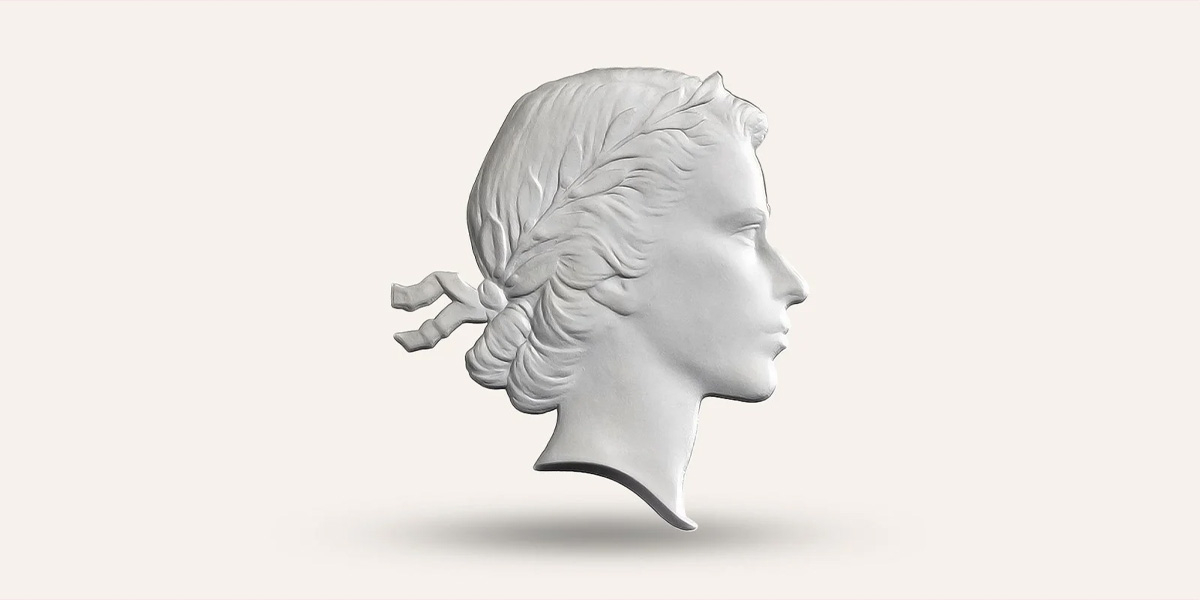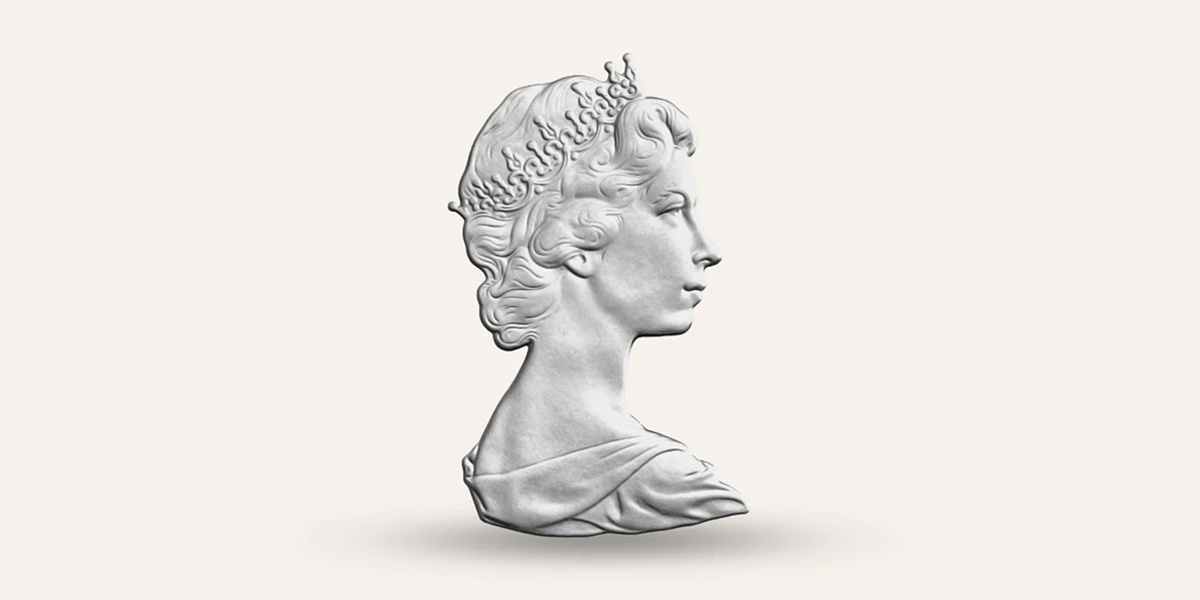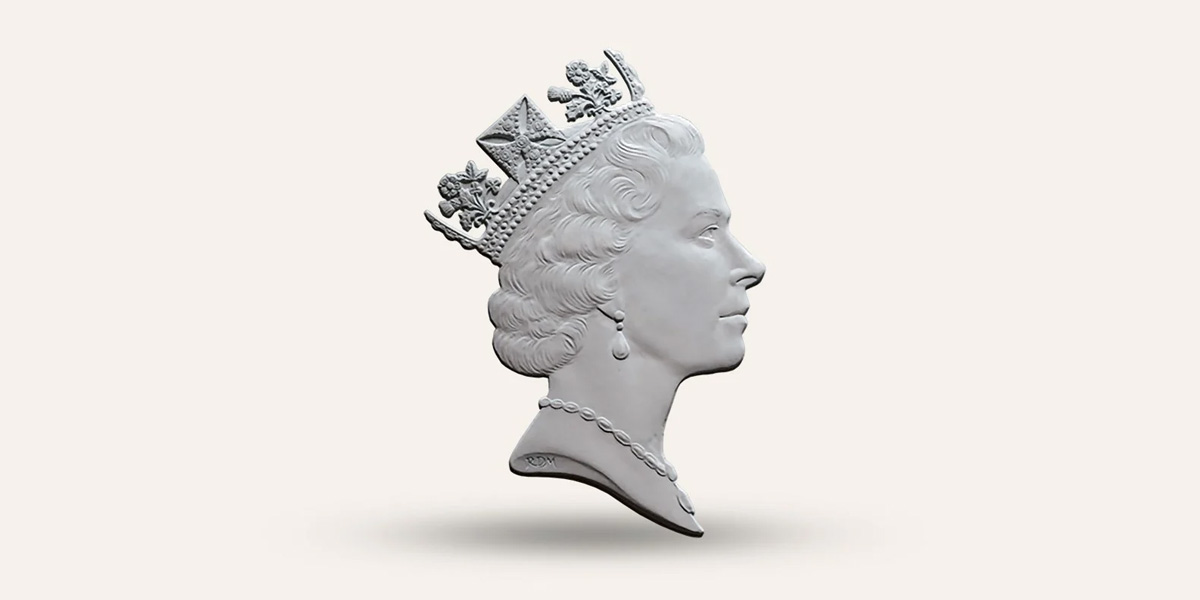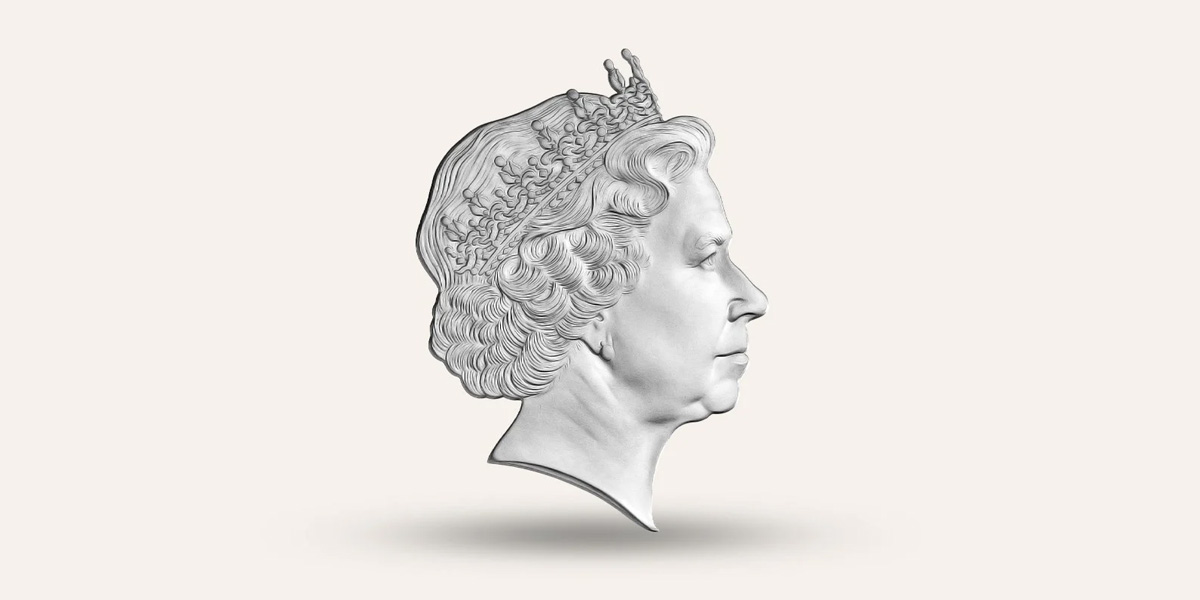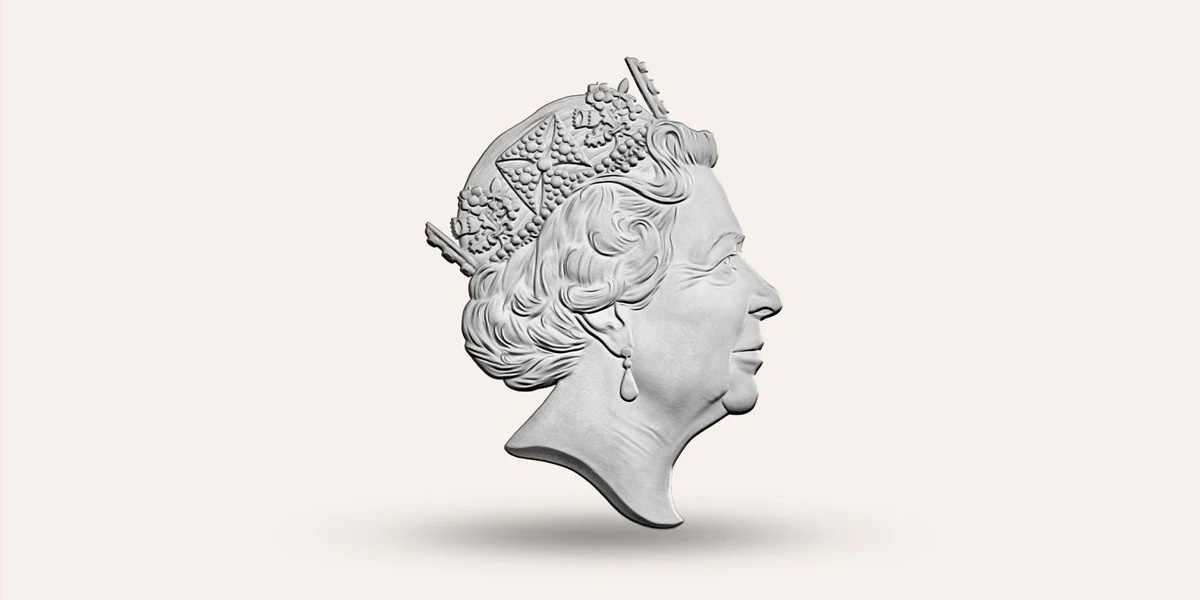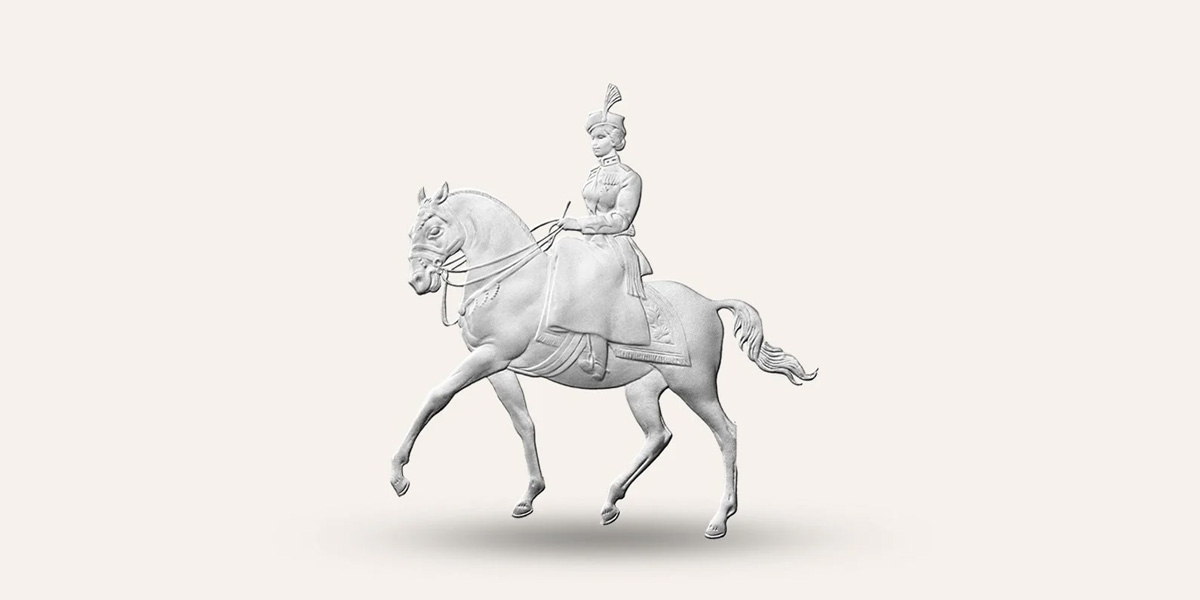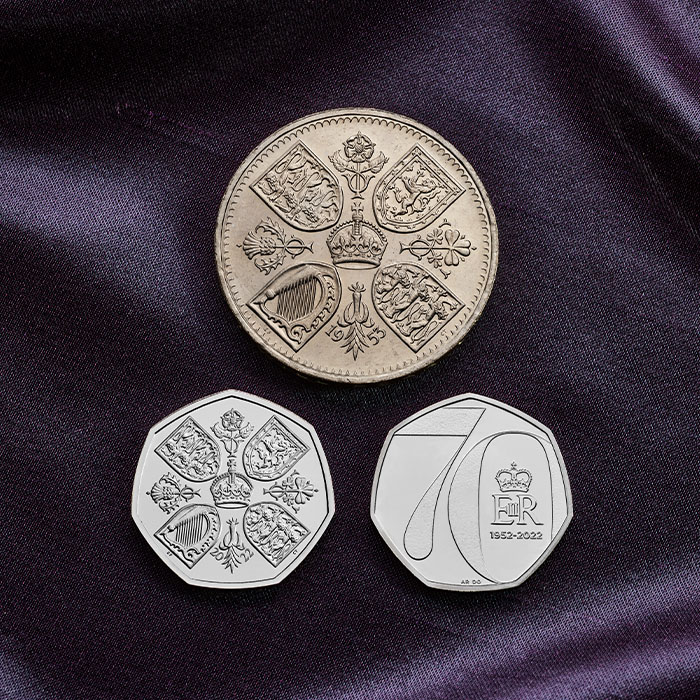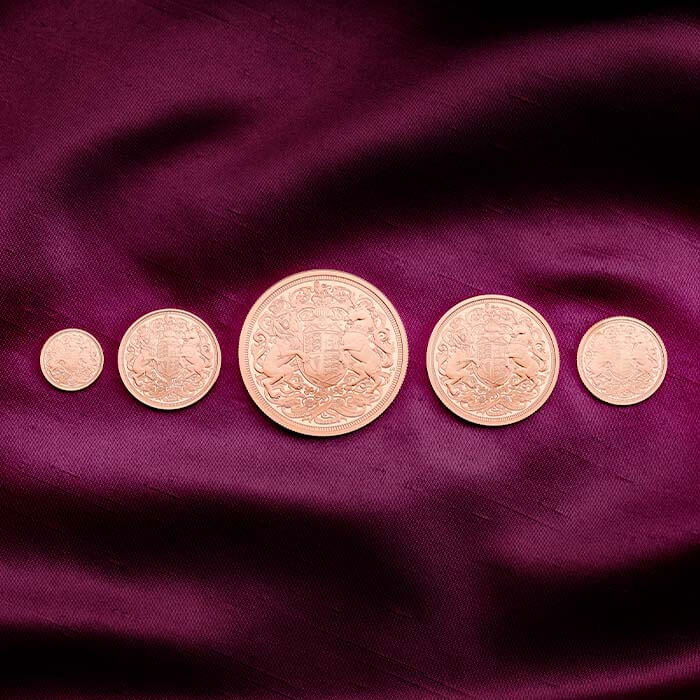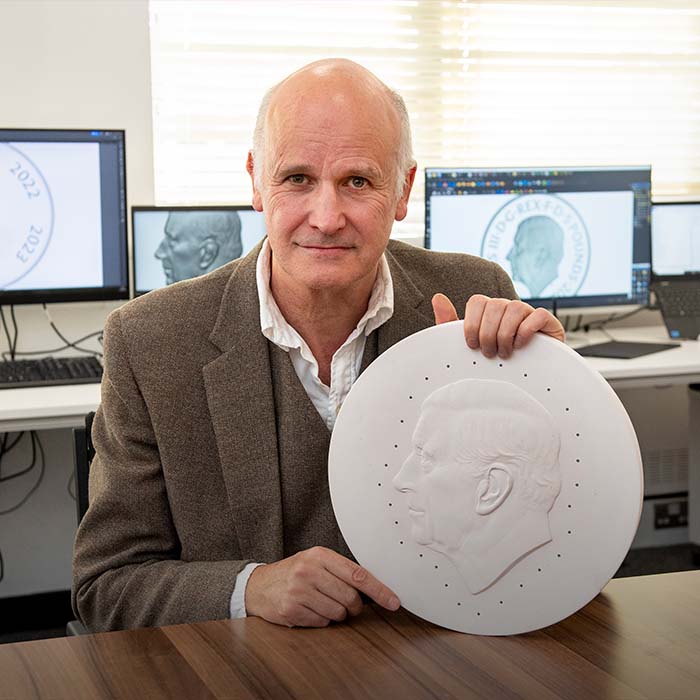As Britain’s longest-reigning monarch, Her Majesty The Queen has been immortalised on our coins many times over, with five definitive coinage portraits that create the ‘official record’ of her reign and special portraits created for important milestones such as birthdays, anniversaries and jubilees.
Her Majesty’s first coinage portrait appeared in 1953 – the year of her coronation – and in 2015, her fifth and most recent definitive coinage portrait made an appearance – the same year The Queen became Britain’s longest-reigning monarch. Each portrait of The Queen portrays this remarkable woman from a unique viewpoint through each artist’s interpretation and style. Together, these artistic elements combine to chart a particular era in British history often referred to as the ‘new Elizabethan age’.
Mary Gillick
The First Definitive Coinage Portrait, 1953
In 1952, the sculptor and medallist Mary Gillick was one of 17 artists invited to submit designs for the first coinage portrait of Queen Elizabeth II, who had ascended the throne in February 1952. Gillick worked in an unusual studio in Chelsea – a small chapel in a Moravian burial ground – where she created large-scale sculptures in stone and bronze, specialising in ‘bas-relief’, which is the art of working in an extremely low depth.
For the new effigy, the famed society photographer Dorothy Wilding photographed the young queen in profile to inform the artists’ designs. Gillick won the competition held by The Royal Mint Advisory Committee (RMAC) with a light, beautiful and fresh portrait of the young monarch unencumbered by a crown and instead wearing a laurel wreath in the classical style.
Upon its release, the design attracted both criticism and celebration – some deemed it too youthful and others favoured Gillick’s approach:
‘… she had tried to portray the Queen as a young woman, but with no specific age in mind. It was youth, not a certain number of years, that she attempted to capture in the portrait.’
An excerpt from The Daily Telegraph issued on 26 November 1952
In the process of refining her submission ready for striking, she was guided by the RMAC, which included His Royal Highness The Prince Philip, Duke of Edinburgh as President, who visited Gillick’s studio during the process. The length of The Queen’s neck was queried although Humphrey Paget, the creator of the coinage portrait of George VI – Her Majesty’s father – and a runner up in the competition to create Her Majesty’s portrait, is quoted as confirming that, ‘… oddly enough the designer is quite right. I took measurements. The Queen has a long neck.’ The Telegraph also commented that The Duke of Edinburgh had made his own suggestions, perhaps on one of his visits, claiming that ‘The Duke of Edinburgh gave her advice. It was about that neck again. The Duke found no fault with the length, but disapproved of the curve.’
Arnold Machin RA
The Second Definitive Coinage Portrait, 1968
With decimalisation fast approaching, many thought that a new coinage portrait of The Queen would help aid the public in distinguishing the new coins from the old. Behind the scenes, teams competed for the honour of creating the new portrait, including a team from the Royal Academy that included the sculptor Arnold Machin RA, who ultimately won the competition to produce the portrait. Machin was clear that he wished to,
“… produce a design with charm and dignity and yet without sentimentality. To create an illusion of strong relief, thereby counteracting the stringent limits of the actual projection essential in coin production. To attempt to recapture something of the richness and vitality of the earlier coins which has not seemed possible with the limiting techniques of modern mass production.”
The Queen sat for Machin four times, making sketches and then modelling in clay, and The Duke of Edinburgh was closely involved in the process. Machin modelled The Queen on one day and she sat for the artist Peter Greenham the following. Machin recalled,
“[Greenham] told me later that The Queen had chatted to him about me. She said, ‘The Duke came in to look at my model and commented that the chin wanted to be stronger and needed more clay, which Mr Machin did – but as soon as the Duke left he took it off again!’”
Raphael Maklouf
The Third Definitive Coinage Portrait, 1985
The RMAC invited the artist Raphael Maklouf to submit designs for their competition in which they would select a new coinage portrait for Queen Elizabeth II. In the previous competition, Arnold Machin had rejected the official photographs given to all those competing and Maklouf was not happy with the supplied profile photograph of The Queen. He remembers:
“By coincidence, I was invited at that time to one of the royal garden parties and, having been introduced to Her Majesty, I remarked to her that I was working from a less than satisfactory photograph. She responded by saying that she would tell Lord Snowdon.”
From the models submitted, Maklouf’s was the successful entry and The Queen granted the artist two live sittings. Again, like Machin, the sculptor worked in clay and the artist explained that he preferred to work directly from a subject rather than taking photographs, measurements and creating preliminary sketches.
“Her Majesty exclaimed that I took less time to complete the portrait in front of her eyes than it sometimes took photographers to get the ‘right lighting and take the photographs.’”
Raphael Maklouf
Although Maklouf strove for and valued a sense of immediacy in his work, his finished effigy was somewhat stylised and a representation of the monarch rather than a direct likeness. Accused by some of being ‘flatteringly young’, Maklouf firmly rejected the criticism, saying his intention ‘… which was to sculpt a symbol and not just a photographic image’, had been misunderstood.
Ian Rank-Broadley FRBS
The Fourth Definitive Coinage Portrait, 1998
During his studies and travels, Ian Rank-Broadley FRBS developed a great admiration for the work of the famed Italian engraver Benedetto Pistrucci. The low-relief sculptures created by Ian Rank-Broadley are greatly admired and over the years, he has established a reputation as one of Britain’s leading sculptors. In 1996, he received an invitation to participate in a competition to design a new royal portrait, recalling that he ‘wanted a portrait that was clearly recognisable and would be modelled in such a way that it would read well in the low-relief medium of coinage’.
In a recurring theme, the sculptor was not pleased with the photographs supplied for the design and looking at further images highlighted a challenge – he needed to be respectful and reflect a sense of The Queen’s age.
“Age is no respecter of persons, royal or otherwise, and although I was aware that my work might attract criticism, I felt that it was essential to the integrity of the project for the portrait to be a recognizable one, and not over-idealised.”
Ian Rank-Broadley
The sculptor submitted three versions of his model to the RMAC. Shortlisted for trial pieces, he was sure the strength of his design would win through, as the large portrait would fill as much as the fields of the smaller new coins as possible.
The notes from the working relationship with the RMAC include changing where the inscription started on the coin and one enormous challenge – introducing the hint of a smile to the portrait:
“It was more difficult to introduce a smile because the complex relationship of facial muscles do not allow one to indicate a particular expression without changing the surrounding features, and thus in a subtle way changing the whole look of the face. Eventually after minutely readjusting the many elements I submitted the revised model that was then developed into a trial piece.”
Ian Rank-Broadley
The sculptor found the shallowness of the coin’s relief frustrating and ‘came to see this as a challenge to render the image successfully’. It took months of work to perfect the design and overcome the technical issues of the medium of coinage but on the release of the new effigy into circulation in early 1998, the design depicted a realistic portrait of a subject that in the artist’s own words, ‘… needed no flattery’.
“For myself, I hope that in time I may be regarded as having made a valuable contribution to the rich and varied history of coinage in this country. When I see my initials IRB beneath the royal effigy on the coins as a record of my achievement, I feel honoured.”
Ian Rank-Broadley
Jody Clark
The Fifth Definitive Coinage Portrait, 2015
In 2015, the RMAC held a ‘closed competition’ in order to select a new coinage portrait of The Queen. Amongst the designers invited to participate were those at The Royal Mint, with each entry submitted anonymously to allow the consideration of each design on its own merits. The portrait approved by Her Majesty’s Treasury and ultimately The Queen herself shows the monarch wearing the Royal Diamond Diadem crown from her coronation. Created by Jody Clark, the choice meant that for the first time in more than 100 years – since George William de Saulles engraved the portrait of Edward VII in 1902 – a designer at The Royal Mint was behind the definitive coinage portrait that would appear on UK coins.
“Everyone who entered the competition was supplied with the same reference material, showing The Queen facing different ways and in a number of different angles. I also did quite a lot of research online to find more natural, unposed images of her. I looked at the designs of the previous effigies and I wanted my design to work as part of that set as well as to work on its own.”
Jody Clark
Found on UK coins that have entered circulation since 2015, Jody Clark’s design remains the current definitive coinage portrait of Queen Elizabeth II.
John Bergdahl
The Platinum Jubilee Commemorative Portrait, 2022
To mark the Platinum Jubilee, the experienced coinage artist John Bergdahl has created a celebratory portrait of The Queen for our commemorative coin collection honouring the occasion. Reminiscent of the 1953 coronation crown created by Gilbert Ledward RA, the design features Her Majesty on horseback in the uniform of the Horse Guards.
“I decided to differentiate the familiar equestrian portrait by including the royal garter taken from the Royal Coat of Arms.”
John Bergdahl

